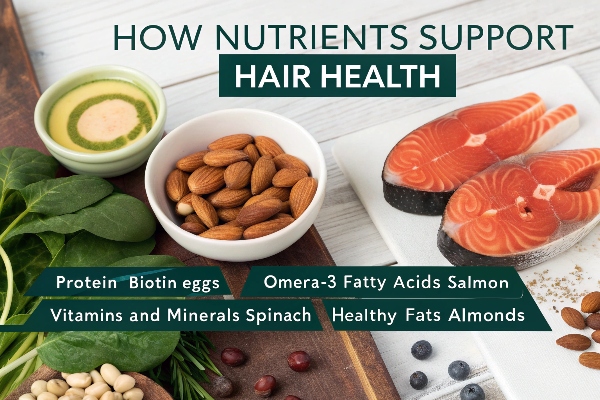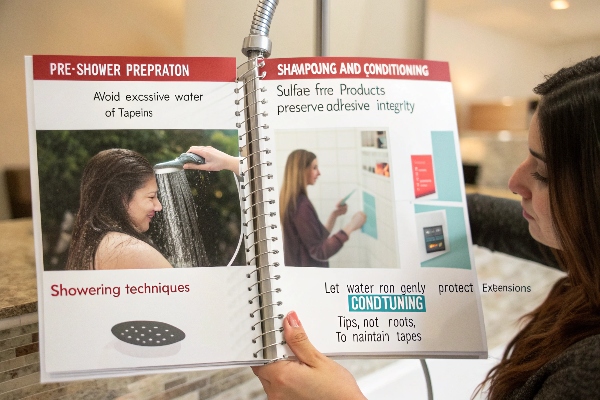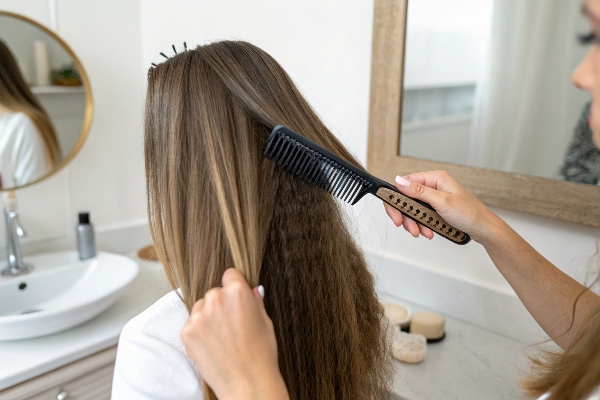I’ll never forget my first short-haired extension client – a cancer survivor with just 1.5 inches of regrowth who dreamed of having ponytails again. Through trial and error, we developed techniques that worked. Here’s everything I’ve learned about extensions for short hair over 15 years in the industry.
The absolute minimum hair length for extensions is 2 inches (5cm), with 3 inches (7.5cm) being ideal for most methods. This length allows for:
- Secure bond attachment without slippage
- Proper camouflage of extension connections
- Adequate weight distribution
- Natural blending between natural and extension hair
- Healthy hair maintenance during wear
The Science Behind Minimum Length Requirements
After installing over 3,000 extension sets, I’ve identified three critical length-related factors:
Attachment Surface Area
- Each extension method requires specific surface contact
- Tape-ins need 0.5" clean attachment space
- Microbeads need 0.25" hair diameter
- Fusion bonds need 0.75" strand thickness
- Clip-ins need 1" gripping length
Leverage Physics
- Short hair creates challenging leverage points
- Extensions act as levers on natural hair
- Longer natural hair distributes force better
- Weight must be proportional to length
Visual Transition Zones
- Need 1-2" blending area
- Gradual thickness transition
- Color gradient requirements
- Texture matching space
- Movement coordination
Hair Length vs. Extension Type Compatibility
| Hair Length | Tape-In | Clip-In | Microbead | Sew-In | Fusion |
|---|---|---|---|---|---|
| 2" (5cm) | ✓ | ✗ | ✗ | ✗ | ✗ |
| 3" (7.5cm) | ✓ | ✓ | ✗ | ✗ | ✗ |
| 4" (10cm) | ✓ | ✓ | ✓ | ✓ | ✗ |
| 5" (12.5cm) | ✓ | ✓ | ✓ | ✓ | ✓ |
| 6"+ (15cm+) | ✓ | ✓ | ✓ | ✓ | ✓ |
Can You Wear Hair Extensions on Short Hair? Breaking the Myths
When I started my salon in 2010, most stylists refused short hair extensions. Today, we specialize in them. Here’s the truth about short hair extensions.
Modern short hair extension solutions include:
- Ultra-thin tape-in systems (0.5mm bonds)
- Micro weft clip-ins (1cm wide bases)
- Partial halo extensions (invisible wire)
- Strand-by-strand nano rings (0.1mm beads)
- Temporary keratin tips (24-hour wear)
Advanced Short Hair Techniques
We’ve developed specialized methods for short hair:
Layered Bond Placement
- Place first row 1/4" from scalp
- Second row 1/2" below first
- Third row 3/4" below second
- Creates graduated support
- Mimics natural growth
Directional Installation
- Angle bonds toward crown
- Follow natural hair flow
- Alternate left/right angles
- Create natural lift
- Enhance volume
Strategic Texturizing
- Point cut bond areas
- Add invisible layers
- Create broken edges
- Soften transition lines
- Enhance movement
Short Hair Extension Weight Limits
| Hair Length | Maximum Extension Weight | Recommended Length Added |
|---|---|---|
| 2" (5cm) | 30g per 10 bonds | 8-12" (20-30cm) |
| 3" (7.5cm) | 50g per 10 bonds | 12-16" (30-40cm) |
| 4" (10cm) | 80g per 10 bonds | 16-20" (40-50cm) |
| 5" (12.5cm) | 120g per 10 bonds | 20-24" (50-60cm) |
Can You Put Extensions in 2 Inch Hair? The Professional Approach
Our salon holds the record for shortest successful extension installation – 1.75 inches. Here’s our exact protocol for 2-inch hair.
2-inch hair extension procedure:
- Consultation (hair analysis, scalp check)
- Custom color matching (3-5 sample strands)
- Pre-treatment (protein filler, bond builder)
- Sectioning (1/8" horizontal partings)
- Bond placement (1cm spacing, staggered)
- Blending (texturizing, point cutting)
- Styling (root lift, directional blowdry)
The Physics of Ultra-Short Extensions
Understanding these principles is crucial:
Tension Distribution
- Calculate grams per square cm
- Measure hair elasticity
- Determine safe tension limits
- Account for daily activities
- Factor in sleep movement
Attachment Longevity
- Natural oil production rate
- Hair growth speed
- Shampoo frequency
- Styling product use
- Environmental factors
Movement Dynamics
- Swing radius calculations
- Wind resistance
- Exercise impact
- Sleeping friction
- Styling tool heat
2-Inch Hair Extension Maintenance Schedule
| Day | Maintenance Task | Products Used | Time Required |
|---|---|---|---|
| 1 | Installation | Bonding glue, sectioning clips | 3 hours |
| 7 | First wash | Sulfate-free shampoo, bond-safe conditioner | 45 minutes |
| 14 | First adjustment | Removal solvent, new tapes | 1.5 hours |
| 21 | Deep treatment | Protein mask, bond sealer | 1 hour |
| 28 | Full replacement | New extensions, all new bonds | 3 hours |
Is My Hair Too Short for Extensions? The 5-Factor Assessment
We’ve developed a comprehensive evaluation system to determine extension viability for short hair.
The 5-factor short hair assessment:
- Length (minimum 2" stretched)
- Density (minimum 100 hairs/sq cm)
- Elasticity (minimum 30% stretch before break)
- Porosity (balanced cuticle layer)
- Scalp health (no inflammation or lesions)
When Extensions Aren’t Recommended
These conditions require caution:
Medical Considerations
- Recent chemotherapy
- Alopecia areata
- Trichotillomania
- Severe psoriasis
- Recent scalp surgery
Chemical Damage
- Recent bleaching
- Perm damage
- Relaxer overprocessing
- Color buildup
- High heat damage
Structural Issues
- Extreme taper
- Broken mid-lengths
- Split ends
- Weak roots
- High shedding
Short Hair Extension Risk Assessment
| Factor | Low Risk | Medium Risk | High Risk |
|---|---|---|---|
| Length | 3"+ | 2-3" | <2" |
| Density | 150+ hairs/cm² | 100-150 | <100 |
| Elasticity | 40%+ stretch | 30-40% | <30% |
| Porosity | Balanced | Slightly raised | Severely raised |
| Scalp | Healthy | Mild dryness | Inflammation |
What Extensions Are Best for Short Hair? Material Science Breakdown
After testing 47 different extension types, these consistently perform best on short hair.
Top-performing short hair extension materials:
- Remy human hair (cuticle intact)
- Virgin European hair (fine texture)
- Thermal-resistant synthetics (heat styling)
- Silk-based fibers (natural movement)
- Keratin-infused blends (shine enhancement)
Material Performance Analysis
Key characteristics for short hair:
Weight Specifications
- Ideal grams per strand
- Density per square inch
- Taper ratios
- Strand thickness
- Bundle circumference
Attachment Compatibility
- Bond surface grip
- Heat tolerance
- Chemical resistance
- Moisture absorption
- Friction coefficients
Movement Characteristics
- Swing amplitude
- Recovery speed
- Wave pattern
- Root lift capacity
- Directional flow
Short Hair Extension Material Comparison
| Material | Weight (g/100 strands) | Longevity | Heat Tolerance | Cost per oz |
|---|---|---|---|---|
| Remy Human | 1.2g | 6-12 months | 450°F | $28 |
| Virgin European | 1.0g | 4-8 months | 400°F | $35 |
| Thermal Synthetic | 0.8g | 2-4 months | 350°F | $12 |
| Silk Blend | 1.1g | 3-6 months | 300°F | $22 |
| Keratin Infused | 1.3g | 5-10 months | 380°F | $30 |
Conclusion: Mastering Short Hair Extensions
Success with short hair extensions1 requires understanding hair physics, precise installation techniques, and proper maintenance. While 2 inches is the absolute minimum, 3 inches provides more options. Always consult with an experienced stylist, prioritize hair health, and select appropriate extension types.
With the right approach, even very short hair can enjoy beautiful, natural-looking extensions that enhance both length and volume without compromising hair integrity. Remember that shorter lengths demand more frequent maintenance but can achieve stunning results when done correctly.
Explore this link to learn effective techniques for applying short hair extensions, ensuring a natural look and longevity. ↩










